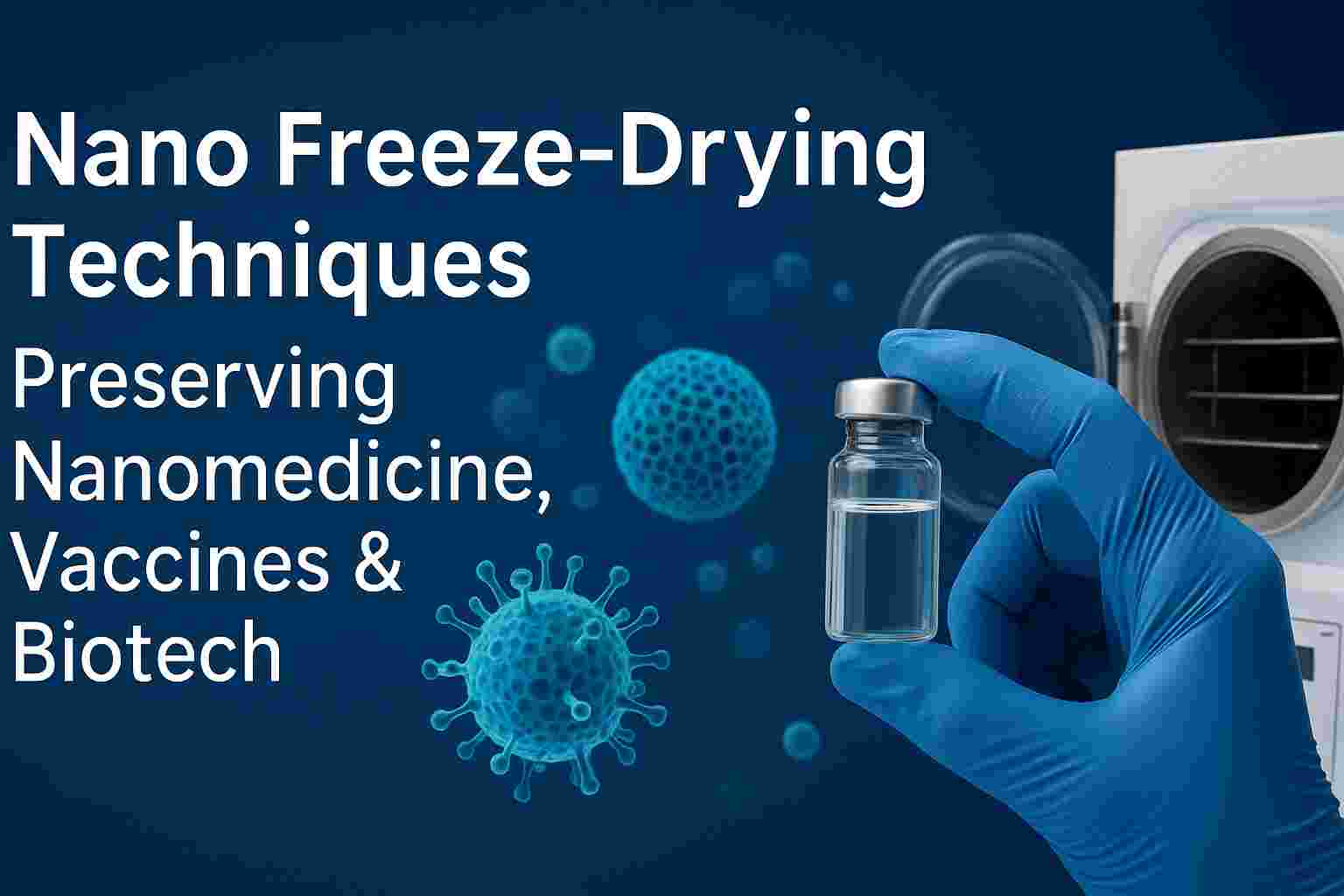Nano Freeze-Drying Techniques: Advancing Nanomedicine, Vaccines, and Biotech Preservation
Introduction
Nano Freeze-Drying Techniques are emerging as a groundbreaking innovation in the field of biopharmaceutical preservation. As nanomedicine, vaccines, and advanced biotech samples gain importance in modern healthcare, the demand for highly stable and long-lasting storage solutions has increased. Traditional lyophilization methods have played a critical role for decades, but nanoscale formulations require precision, efficiency, and optimization beyond conventional freeze-drying. By integrating nanotechnology with lyophilization, scientists can preserve delicate structures, improve drug stability, and ensure sterility, ultimately driving advancements in biotechnology and pharmaceutical manufacturing.
In this article, we will explore the fundamentals of nano freeze-drying, its advantages, critical applications in nanomedicine and vaccines, challenges, regulatory considerations, and the future of this evolving technology.
What Are Nano Freeze-Drying Techniques?
Nano freeze-drying techniques refer to the application of lyophilization at the nanoscale, focusing on preserving nanoformulations such as nanoparticles, liposomes, mRNA vaccines, monoclonal antibodies, and nanocarriers. These nanoscale products are highly sensitive to heat, moisture, and oxidation, making freeze-drying the preferred method for extending their shelf life.
Unlike conventional freeze-drying, where bulk solutions or powders are preserved, nano freeze-drying aims to:
- Maintain nanoparticle size and morphology.
- Protect bioactivity of sensitive molecules.
- Ensure reconstitution without aggregation.
- Enhance stability during long-term storage.
Importance of Nano Freeze-Drying in Nanomedicine
Nanomedicine involves the use of nanoparticles to deliver drugs with higher precision, fewer side effects, and improved therapeutic effects. However, these formulations are unstable in liquid form. Nano freeze-drying techniques solve this problem by stabilizing nanoparticles in a solid state while retaining their biological functionality.
Key Benefits for Nanomedicine:
- Controlled Drug Delivery: Preserved nanoparticles ensure accurate targeting.
- Enhanced Bioavailability: Reduced degradation during storage.
- Scalable Manufacturing: Easier transport and storage of lyophilized powders.
- Improved Patient Safety: Stable products lower contamination risks.
For a deeper understanding of freeze-drying process parameters, you can explore this essential guide.
Applications of Nano Freeze-Drying Techniques
1. Nanomedicine Preservation
Nano freeze-drying ensures the integrity of liposomes, polymeric nanoparticles, and nanocarriers used for drug delivery. These systems are often prone to aggregation, but controlled lyophilization helps maintain uniformity.
2. Vaccines and Biologics
mRNA and protein-based vaccines, such as COVID-19 formulations, benefit significantly from nano freeze-drying. This method enhances their thermal stability, reducing dependency on ultra-cold storage. Related insights can be found in continuous freeze-drying in pharmaceuticals.
3. Biotech Research Samples
From genetic material to antibodies, nano freeze-drying offers a reliable solution for sample stability in laboratories and clinical trials.
4. Personalized Medicine
As precision medicine grows, patient-specific nanoformulations require highly reliable preservation. Nano freeze-drying provides the needed consistency.
Working Principle of Nano Freeze-Drying Techniques
The process follows the same basic freeze-drying steps but optimized at the nanoscale:
-
Freezing Phase – Nanoformulations are rapidly frozen using cryogenic techniques to prevent ice crystal growth that can damage structures.
-
Primary Drying (Sublimation) – Under vacuum, ice transitions directly to vapor, preserving nanoparticle morphology.
-
Secondary Drying (Desorption) – Residual water molecules are removed to achieve ultra-low moisture levels.
-
Sealing & Storage – Lyophilized nano-products are sealed in sterile vials or containers.
For advanced monitoring during drying, AI-based monitoring systems are increasingly integrated.
Advantages of Nano Freeze-Drying Techniques Over Conventional Methods
- Higher Stability of nanomedicine formulations.
- Reduced Cold Chain Dependence, especially for vaccines.
- Better Shelf Life for biotech samples.
- Improved Redispersion into original nanoparticle size after reconstitution.
- Scalability in GMP-compliant facilities.
For further optimization practices, see this guide on lyophilization process efficiency.
Technical Challenges in Nano Freeze-Drying Techniques
Despite its promise, several hurdles remain:
- Formulation Instability – Nanoparticles may aggregate if not stabilized with cryoprotectants.
- Equipment Costs – Advanced freeze dryers with precise controls are expensive. Installation ROI becomes critical.
- Process Optimization – Achieving balance between drying efficiency and nano preservation is complex.
- Regulatory Compliance – Strict GMP guidelines must be followed for nanomedicine products.
Role of Cryoprotectants in Nano Freeze-Drying
Cryoprotectants such as trehalose, sucrose, and DMSO are widely used to protect nanoscale formulations from freeze-induced damage. They create a glassy matrix around nanoparticles, preventing aggregation and maintaining bioactivity. For a full guide, check cryoprotectants in freeze-drying.
Process Analytical Technology (PAT) in Nano Freeze-Drying
Process Analytical Technology ensures real-time monitoring of critical quality attributes during freeze-drying. In nano freeze-drying, PAT tools measure moisture content, particle size, and product temperature, ensuring consistency. Explore more about PAT in freeze-drying.
Regulatory Considerations for Nano Freeze-Drying
Regulatory bodies such as the FDA and EMA have introduced stringent requirements for freeze-dried pharmaceuticals, especially nanomedicines. Guidelines cover:
- Good Manufacturing Practices (GMP) – GMP Freeze-Drying Guidelines.
- Product sterility and quality standards.
- Documentation for freeze-drying validation and qualification.
Future Trends in Nano Freeze-Drying Techniques
- AI and Machine Learning Integration for predictive defect prevention.
- Continuous Nano Freeze-Drying replacing traditional batch processes.
- Green Freeze-Drying Solutions for sustainability.
- Smart Monitoring Systems for real-time nanoformulation tracking.
- Integration with Personalized Medicine for tailored treatments.
FAQs on Nano Freeze-Drying Techniques
What are Nano Freeze-Drying Techniques?
They are advanced lyophilization methods designed to preserve nanomedicine, vaccines, and biotech samples with high precision.
Why are they important for nanomedicine?
They stabilize nanoparticles, improve drug delivery, and extend product shelf life.
How do nano freeze-drying techniques differ from traditional freeze-drying?
They focus on preserving nanoscale structures and preventing aggregation.
Can vaccines benefit from nano freeze-drying?
Yes, vaccines achieve enhanced stability and reduced cold chain dependency.
What role do cryoprotectants play in nano freeze-drying?
They protect nanoparticles from damage during freezing and drying.
Is nano freeze-drying cost-effective?
While equipment costs are high, it ensures long-term ROI through stable, transportable products.
How does AI improve nano freeze-drying?
AI-based monitoring enhances process control and defect prevention.
Are there GMP requirements for nano freeze-drying?
Yes, GMP guidelines regulate production, sterility, and product safety.
Which industries use nano freeze-drying?
Pharmaceuticals, biotech, vaccines, and nanomedicine research.
What is the future of nano freeze-drying techniques?
Future trends include continuous processes, AI integration, and personalized medicine applications.
